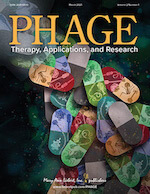Hi everyone,
We found some interesting papers for this month’s Picks!
My biggest takeaway is that the more we learn about how phages, bacteria, and the immune system interact, the more we realize how intricate and complex the entire system actually is, and that there’s a lot more to uncover and understand.
~ Jan
Phage-induced protection against lethal bacterial reinfection
What is it about?
This study shows that phage therapy does more than just kill bacteria — it also trains the immune system to fight off future infections! Researchers used mice infected with a lethal dose of E. coli (a sepsis model) and treated them with a therapeutic phage called HP3. Not only did the phage cure the initial infection, but when they re-infected the same mice 4 weeks later (without giving them any more phage), an amazing 93% survived what should have been a lethal dose. The protection seems to come from phage lysis of the bacteria and releasing hidden antigens that the immune system can learn to recognize, kind of like a personalized vaccine made from the patient’s own infection.
Why I’m excited about it:
This is huge! We’ve always thought of phages as just bacterial killers, but this research shows they might be dual-action therapeutics — both treatment AND vaccination rolled into one. The protection was incredibly strong (reducing bacterial loads by a billion-fold!) and didn’t require any additional phage treatment. The fact that this worked with two completely different phages (though HP3 was best) suggests this might be a broader phenomenon we can harness — and that some phages might have this property more than others (and maybe we should pick those for future therapy).
~ Jess
Paper: https://www.pnas.org/doi/10.1073/pnas.2423286122
Xing, Y., Hernandez Santos, H. J., Qiu, L., Ritter, S. R., Zulk, J. J., Lahowetz, R., Patras, K. A., Terwilliger, A. L., & Maresso, A. W. (2025). Phage-induced protection against lethal bacterial reinfection. Proceedings of the National Academy of Sciences, 122(22), e2423286122. https://doi.org/10.1073/pnas.2423286122
Temperate phages enhance host fitness via RNA-guided flagellar remodeling
What is it about?
This study reveals how certain temperate phages (called Flagellin Remodeling prophages or FRφ) use RNA-guided systems to completely redesign their bacterial host’s flagella. The researchers found that these phages produce proteins called TldR that work like molecular switches to turn off the host’s normal flagellin, and replace it with the phage’s own version. This flagellar redesign gives the bacteria extra properties: they swim better, hide from the immune system more effectively, and colonize the gut more successfully. Using cryo-electron microscopy, the team showed that the phage-modified flagella have completely different structures than normal ones, explaining why they work so much better.
Why I’m excited about it:
This paper actually blows my mind a bit, especially as I studied flagella and (Campylobacter) phage interactions in my PhD — I would have been so psyched to see this then! At the time it felt like it would be crazy to propose that phage were having a hand in what the flagella did… Also, the fact that these RNA-guided systems evolved independently multiple times suggests this is not a fluke and could be a broadly useful strategy. Very cool to think that phages could be helping their bacterial hosts become better at surviving in real-world environments like our guts. I wonder how this might lead to new therapeutic approaches where we could use phages to modify bacteria in beneficial ways.
~ Jess
Preprint: https://www.biorxiv.org/content/10.1101/2025.07.22.666180v1
Walker, M. W. G., Richard, E., Wiegand, T., Wang, J., Yang, Z., Casas-Ciniglio, A. A., Hoffmann, F. T., Shahnawaz, H., Gaudet, R. G., Arpaia, N., Fernández, I. S., & Sternberg, S. H. (2025). Temperate phages enhance host fitness via RNA-guided flagellar remodeling. bioRxiv. https://doi.org/10.1101/2025.07.22.666180
Predicting clinical outcome of Escherichia coli O157:H7 infections using explainable Machine Learning
What is it about?
The authors in this paper collected a bunch of shiga-toxin producing E.coli (STEC) genomes from across the UK, and used two machine learning approaches to predict clinical outcomes of the STEC infections. Using both Random Forest and XGBoost, they were able to correctly predict which isolates were high risk, in what would otherwise have been low-risk lineages.
The researchers were then able to connect the predictions back to what genomic elements led to the predictions (which included phage-encoded elements, and others).
Why I’m excited about it:
I think papers like this show that you can use prediction models to see your phage and isolate bank in different ways, and find new patterns and connections. In this paper, the models found potentially novel intergenic features as highlighted by their “explainable” models (as in, the prediction tells you which features, e.g. k-mers in this case, tells you might be a reason for its high prediction rate). So using methods like this is kind of like presenting key ring of the most viable keys (out of thousands), but you still have to check them. Some doors are already opened, like stx2a in this case, but others could open doors you didn’t even know existed!
~ Jan
Paper: https://www.medrxiv.org/content/medrxiv/early/2025/06/06/2025.06.05.25329036.full.pdf
Paganini, J. A., Khatun, S., McAteer, S., Cowley, L., Greig, D. R., Gally, D. L., Jenkins, C., & Dallman, T. J. (2025). Predicting clinical outcome of Escherichia coli O157:H7 infections using explainable machine learning. medRxiv. https://doi.org/10.1101/2025.06.05.25329036







